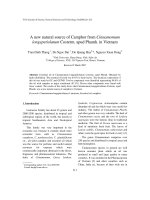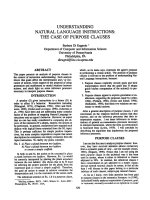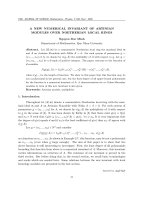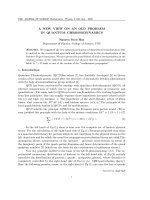Báo cáo "A new 3α-acetoxy-urs-23,28,30-trioic acid from the leaves of Acanthopanax Trifoliatus " doc
Bạn đang xem bản rút gọn của tài liệu. Xem và tải ngay bản đầy đủ của tài liệu tại đây (95.37 KB, 4 trang )
121
Journal of Chemistry, Vol. 42 (1), P. 121 - 124, 2004
A new 3-acetoxy-urs-23,28,30-trioic acid from
the leaves of Acanthopanax trifoliatus
Received 7-7-2003
Phan Van Kiem
1
, Nguyen Tien Dat
3
, Chau Van Minh
1
,
Jung Joon Lee
2
, Young Ho Kim
3
1
Institute of Natural Products Chemistry, Vietnamese Academy of Science and Technology
2
Korea Research Institute of Bioscience and Biotechnology, Daejeon, Korea
3
College of Pharmacy, Chungnam National University, Daejeon, Korea
ABSTRACT
A new 3
-acetoxy-urs-23,28,30-trioic acid, named acantrifoic acid B (1), has been
isolated from the leaves of Acanthopanax trifoliatus. Its chemical structure has been
characterized on the basis of spectral and chemical evidence.
I - INTRODUCTION
Acanthopanax trifoliatus (L.) Merr.,
(Araliaceae) is distributed in North Vietnam and
used in the folk medicines of south–east Asia
(Chi, 1997; Loi, 2001) as a drug with ginseng-
like activity. Lupane-triterpene carboxylic acids
and a lupane-triterpene glycoside have been
reported from the leaves of A. trifoliatus (Ty et
al., 1984; Lischewski et al., 1985; Yook et al.,
1998). As a part of our continuing studies on
Acanthopanax species, we report here the
isolation and the structure determination of a
new compound from A. trifoliatus. Based on
spectroscopic data, the chemical structure of
constituent was determined as 3-acetoxy-urs-
23,28,30-trioic acid (1).
II - RESULTS AND DISCUSSION
Repeated column chromatography on silica
gel of the dichloromethane extract of the dried
leaves of A. trifoliatus yielded a new carboxylic
acid 1. Compound 1 was formed as white
crystals, and produced a due to carbonyl IR
absorption peaks at 1748 - 1750 cm
-1
, acid IR
absorption peaks at 3400 cm
-1
. The FAB-MS
spectrum of 1 showed an [M+H]
+
ion peak at m/z
561, correspond to a molecular formula of
C
32
H
48
O
8
. The
1
H-NMR spectrum of 1 (Table 1)
showed signals due to five tertiary methyl
groups [ 0.96 (3H, s, H
3
-25), 1.01 (3H, s, H
3
-26),
CH
3
-C-O
O
COOH
COOH
COOH
3
4
8
10
13
14
17
19
20
22
23
24
25
26
27
28
29
30
32
Fig. 1: Structure of compound 1
1.04 (3H, d, J = 7.2 Hz, H
3
-29), 1.08 (3H, s,
H
3
-27) and 1.24 (3H, s, H
3
-24)], one oxygen
bearing a proton ( 4.92, H-3) and one acetoxy
proton [ 1.95 (3H, s)]. The
13
C-NMR and
DEPT spectrums revealed 32 carbon signals,
122
including three carboxyl groups at 177.0,
178.0 and 178.1, one ester carbonyl group at
170.0, one oxygen bearing methine carbon at
76.0, and six methyl carbons at 9.8, 15.2,
16.7, 16.9, 17.5 and 21.3. A
1
H-
1
H COSY
experiment allowed analysis of their spin
systems and assignments of their proton
resonances. The assignment of their correspon-
ding carbons, made by a HMQC spectrum. The
C-H long-range correlations between proton
H-3 (
H
4.92) and carbons C-31 (
C
170.0) /
C-32 (
C
21.3), between protons H-3 (
H
4.92) /
H-24 (
H
1.24) and carbon C-23 (
C
177.0),
between protons H-29 (
H
1.04) / H19 (
H
2.70)
and carbon C-30 (
C
178.0), and between
protons H-18 (
H
1.45) / H-22 (
H
1.35) and
carbon C-28 (
C
178.1) were observed in the
HMBC spectrum. This evidence confirmed that
an acetoxy group was connected to C-3, three
carboxyl groups (
C
177.0, 178.1, 178.0) were
connected to C-23, C-28 and C-30, respectively.
Further more, NOESY correlations were
observed between H
-3 [4.92 (1H, br s)] and
H
3
-24 [1.24 (3H, s)]. This evidence confirmed
the location of C-23 carboxyl group. The
chemical shift at
C
76.0 (C-3) is typical for
the location of 3-acetoxy of pentacyclic
triterpenoids (Shashi B. M. et al., 1994). Based
on the
1
H-
1
H COSY, NOESY, HMQC, HMBC
spectral data, compound 1 was determined to
be 3-acetoxy-urs-23,28,30-trioic acid, which
we named acantrifoic acid B.
Table 1:
1
H-,
13
C- NMR spectral data of compound 1 (in acetone-d
6
)
Pos.
C
(150 MHz)
H
(600 MHz)
1 33.7 (t) 1.49 (2H, m)
2 25.2 (t) 1.55 (2H, m)
3 76.0 (d) 4.92 (1H, br s)
4 50.4 (s) -
5 46.1 (d) 1.96 (1H, m)
6 21.6 (t) 1.67 (2H, m)
7 34.9 (t) 1.35 (2H, m)
8 42.2 (s) -
9 51.3 (d) 1.58 (1H, m)
10 37.7 (s) -
11 21.9 (t) 1.52 (2H, m)
12 27.4 (t) 1.82 (2H, m)
13 39.0 (d)
2.45 (1H, dt, J = 12.6, 3.6 Hz)
14 43.6 (s) -
15 30.4 (t) 1.29 (2H, m)
16 23.0 (t) 1.66 (2H, m)
17 57.1 (s) -
18 49.1 (d) 1.45 (1H, m)
19 41.7 (d)
2.7 (1H, dd, J = 10.2, 3.0 Hz)
20 40.8 (d)
2.94 (1H, ddd, J = 7.8, 3.0 Hz)
21 32.8 (t)
2.28 (2H, ddd, J = 7.8, 2.4 Hz)
22 38.1 (t) 1.35 (1H, m); 1.86 (1H, m)
23 177.0 (s) -
24 17.5 (q) 1.24 (3H, s)
25 16.7 (q) 0.96 (3H, s)
123
26 16.9 (q) 1.01 (3H, s)
27 15.2 (q) 1.08 (3H, s)
28 178.1 (s) -
29 9.8 (q)
1.04 (3H, d, J = 7.2 Hz)
30 178.0 (s) -
31 170.0 (s) -
32 21.3 (q) 1.95 (3H, s)
CH
3
-C-O
O
COOH
COOH
COOH
1
H-
1
H COSY
HMBC
Fig. 2: Important H-C correlations in HMBC and H-H correlations
in
1
H-
1
H COSY spectrums of 1
iii - MATERIALS AND METHODS
General experimental procedures
Melting points were determined using a
Yanagimoto micro hot-stage melting point
apparatus. IR spectra was obtained on a JASCO
DIP-370 Digital polarimeter. Optical rotations
were determined on a JASCO DIP-1000 KUY
polarimeter. FAB-MS and HR FAB-MS were
obtained using a JEOL JMS-DX 300 spectro-
meter.
1
H-NMR (600 MHz) and
13
C-NMR (150
MHz) spectra were recorded on a Bruker-
AM600 FT-NMR unit and chemical shifts are
expressed as values using TMS as an internal
standard. Column chromatography (CC) was
performed on silica gel 60.
Plant material
A. trifoliatus was collected in Langson
province, Vietnam in January 2001 and
identified by Prof. Dr. Tran Minh Hoi, Institute
of Ecology, Biological Resourses, Vietnamese
Academy of Science and Technology (VAST).
Voucher specimens (No 2539) are deposited at
the herbarium of the Institute of Natural Product
Chemistry, VAST, and at the herbarium of the
College of Pharmacy, Chungnam National
University, Korea.
Extraction and isolation
Dried and powdered leaves (3.7 kg) were
extracted repeatedly with hot MeOH three times.
The combined solutions were evaporated under
reduced pressure to give MeOH extract (250.0 g),
which was suspended in water and then partitio-
ned with dichloromethane. The dichloro-methane
fraction (56.0 g) was then subjected to repeated
chromatography on a silica gel column, using
hexane-acetone (4 : 1) as eluent and repeatedly
recrystallized from hexane-acetone (8 : 1) to yield
1 (10.0 mg) as white crystals.
3.4 3
-acetoxy-urs-23,28,30-trioic acid (1)
White crystals, m.p. 225 - 228
o
C, []
25
D
-35.7
o
(c 0.51, MeOH); IR
KBr
max
cm
-1
: 3400 (br, -COOH),
124
2890 - 2950 (C-H), 1748 - 1750 (>C=O); FAB-MS
(positive) m/z: 561 [M+H]
+
;
1
H- and
13
C-NMR:
see Table 1.
Acknowledgements: This study was suppor-
ted by a grant from the Vietnam - Korea inter-
national cooperation project. We are grateful
to KBSI for measuring NMR and MS spectra
and we thank to Prof. Dr. Tran Minh Hoi,
Institute of Ecology, Biological Resources,
VAST for the plant identification.
REFERENCES
1. V. V. Chi. Vietnamese Medical Plant
Dictionary. Hanoi Medicine Pub. (1997).
2. D. T., Loi. Glossary of Vietnamese Medical
Plants. Hanoi S&T Pub (2001).
3. M. Lischewski, P. D. Ty, L. Kutschabsky, D.
Pfeiffer, H. V. Phiet, A. Preiss, T. V. Sung,
and G. Adam. Phytochemistry, Vol. 24, P.
2355 - 2357.
4. B. M. Shashi B. M. and P.K. Asish.
Phytochemistry, Vol. 37, P. 1517 - 1575 (1994).
5. S. Siddiqui, B. S. Siddiqui, F. Hafeez, and S.
Begum. Planta Medica, Vol. 54, P. 232
(1988).
6. S. Siddiqui, S. Begum, B. S. Siddiqui, and F.
Hafeez. J. Nat. Prod., Vol. 52, P. 57 (1989).
7. Ph. D. Ty, M. Lischewski, H. V. Phiet, A.
Preiss, T. V. Sung, J. Schmidt, and G. Adam.
Phytochemistry, Vol. 23, P. 2889 - 2891 (1984).
8. C. S. Yook, I. L. Kim, D. Y. Hahn, T. Nohara,
and S. Y. Chang. Phytochemistry, Vol. 49, P.
839 - 843 (1998).









